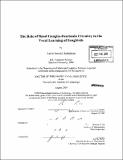The role of basal ganglia-forebrain circuitry in the vocal learning of songbirds
Author(s)
Andalman, Aaron Samuel
DownloadFull printable version (16.85Mb)
Other Contributors
Massachusetts Institute of Technology. Dept. of Brain and Cognitive Sciences.
Advisor
Michale S. Fee.
Terms of use
Metadata
Show full item recordAbstract
The basal ganglia form the largest sub-cortical structure in the human brain and are implicated in numerous human diseases. In songbirds, as in mammals, basal ganglia-forebrain circuits are necessary for the learning and production of complex motor behaviors; however, the precise role of this circuitry remains unknown. This thesis is an investigation into how the anterior forebrain pathway (AFP), an avian basal ganglia-forebrain circuit, supports vocal learning in the songbird. This investigation reveals two previously undiscovered functions of the AFP - both related to reinforcement, or trial-and-error, learning. One necessary component of reinforcement learning is the generation of variable behavior. The songs of learning juvenile birds are naturally highly variable. Rapid pharmacological inactivation of the AFP output nucleus causes an immediate and dramatic reduction in this variability. In addition, the first single-unit recordings of AFP output neurons in singing juvenile birds reveal little correlation with plastic song and a premotor correlation with the most variable form of singing, subsong. These results suggest a novel function for basal ganglia-forebrain circuitry in the production of exploratory behavior. A second component of reinforcement learning is the evaluation of performance-based feedback - auditory feedback in the case of singing. Conditional disruptive auditory feedback is a novel behavioral paradigm capable of causing rapid experimentally-controlled vocal learning. Inactivating the AFP while using this new paradigm to induce learning reveals that the AFP biases motor output to improve auditory feedback. This result suggests that basal gangliaforebrain circuits are involved in the evaluation of performance-based feedback. It also suggests for the first time that these circuits are capable of producing temporally precise premotor drive that incrementally improves a motor skill. In summary, this investigation significantly furthers the view that basal ganglia-forebrain circuitry is involved in reinforcement learning. It ascribes two functions to the anterior forebrain pathway: to drive variable behavior; and to bias future behavior incrementally towards better performance. By analogy, basal ganglia-thalamocortical loops may perform similar functions in mammals.
Description
Thesis (Ph. D.)--Massachusetts Institute of Technology, Dept. of Brain and Cognitive Sciences, 2009. Cataloged from PDF version of thesis. Includes bibliographical references.
Date issued
2009Department
Massachusetts Institute of Technology. Department of Brain and Cognitive SciencesPublisher
Massachusetts Institute of Technology
Keywords
Brain and Cognitive Sciences.